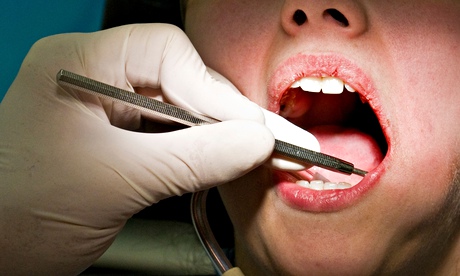No more fillings as dentists reveal new tooth decay treatment
Scientists in London develop pain-free filling that allows teeth to repair themselves without drilling or injections

The new treatment, Electrically Accelerated and Enhanced Remineralisation (EAER), could be available within three years. Photograph: Hermes Morrison 2/Alamy
Scientists have developed a new pain-free filling that allows cavities to be repaired without drilling or injections.
The tooth-rebuilding technique developed at King's College London does away with fillings and instead encourages teeth to repair themselves.
Tooth decay is normally removed by drilling, after which the cavity is filled with a material such as amalgam or composite resin.
The new treatment, called Electrically Accelerated and Enhanced Remineralisation (EAER), accelerates the natural movement of calcium and phosphate minerals into the damaged tooth.
A two-step process first prepares the damaged area of enamel, then uses a tiny electric current to push minerals into the repair site. It could be available within three years.
Professor Nigel Pitts, from King's College London's Dental Institute, said: "The way we treat teeth today is not ideal. When we repair a tooth by putting in a filling, that tooth enters a cycle of drilling and re-filling as, ultimately, each 'repair' fails.
"Not only is our device kinder to the patient and better for their teeth, but it's expected to be at least as cost-effective as current dental treatments. Along with fighting tooth decay, our device can also be used to whiten teeth."
A spinout company, Reminova, has been set up to commercialise the research. Based in Perth, Scotland, it is in the process of seeking private investment to develop EAER.
The company is the first to emerge from the King's College London Dental Innovation and Translation Centre, which was set up in January to take novel technologies and turn them into new products and practices.
King's College is a participant in MedCity, a project launched by the London mayor, Boris Johnson, to promote entrepreneurship in the London-Oxford-Cambridge life sciences "golden triangle".
The chairman of MedCity, Kit Malthouse, said: "It's brilliant to see the really creative research taking place at King's making its way out of the lab so quickly and being turned into a new device that has the potential to make a real difference to the dental health and patient experience of people with tooth decay."
-----
Regenerating teeth
An enlightened approach
It may be possible to stimulate decayed teeth to repair themselves May 31st 2014 |
 Goodbye to all that
Goodbye to all that REGENERATIVE medicine is a field with big ambitions. It hopes, one day, to repair or replace worn-out hearts, livers, kidneys and other vital organs. Many people, though, would settle for a humbler repair—of their teeth.
Dentistry has too much “drill and fill”, cutting away infected tissue and replacing it with alien, artificial materials. But if work by people such as David Mooney of Harvard University comes to fruition, the days of drill and fill may be numbered. For, as they report in Science Translational Medicine, Dr Mooney and his team have found a surprising way to get dentine, the tissue that underlies a tooth’s enamel coat, to repair itself. They do so by shining a laser beam at it.
Regenerative medicine boils down to the intelligent manipulation of stem cells. A stem cell is one that has the capacity to split asymmetrically so that one daughter remains a stem cell (and can thus go on to perform the same trick) while the other gives birth to a line which proliferates and differentiates into many other sorts of cell. The most famous, and controversial, stem cells are those in early embryos. These can turn into any sort of body cell. Mature tissues such as dentine contain stem cells of more limited capability, which keep up a supply of new specialised cells to replace old ones as they die.
Dr Mooney’s trick is to tickle dentine’s stem cells in a way that encourages them to proliferate and produce more dentine. And that is where the laser comes in. The light it shines creates chemically potent, oxygen-rich molecules such as hydrogen peroxide which go on to activate latent versions of molecules called transforming growth factor–beta 1 (TGF-beta 1). These, in turn, activate dentine’s stem cells and encourage the tissue’s growth.
Dr Mooney and his team have shown that this works in both tissue cultures and actual (rats’) teeth. Moreover, blocking the action of TGF-beta 1 with a drug, or by knocking out the gene that encodes the growth factor’s receptor, stops it happening, which suggests they have understood the mechanism correctly.
This is a preliminary result, and it does not address the question of whether enamel might similarly be repaired. But it is encouraging. Eventually, perhaps, dentists will approach cavities with lasers rather than drills—and the days of fillings will be over. - See more at: http://www.economist.com/news/science-and-technology/21602989-it-may-be-possible-stimulate-decayed-teeth-repair-themselves-enlightened?fsrc=scn%2Ffb%2Fwl%2Fpe%2Fanenlightenedapproach#sthash.vhcWn7xZ.dpuf
------
Dentistry has too much "drill and fill", cutting away infected tissue and replacing it with alien, artificial materials. But if work by people such as David Mooney of Harvard University comes to fruition, the days of drill and fill may be numbered. Dr Mooney and his team have found a surprising way to get dentine, the tissue that underlies a tooth's enamel coat, to repair itself http://econ.st/1iz5skc

沒有留言:
張貼留言